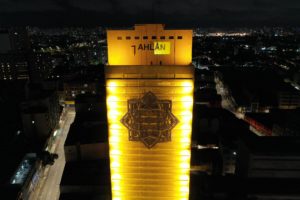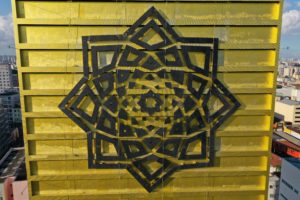São Paulo – A 444-square-meter arabesque sculpture was installed at a height of 70 meters from the floor on the front of Edifício Garagem Automática Senador, which had its 2,000-square-meter surface painted with golden paint, in addition to lights that make the building glow at night to illuminate São Paulo’s Historic Center, just around the corner of Rua 25 de Março and Avenida Senador Queirós.

The artwork Ahlan, produced in tribute to the Arab immigration in Brazil, was finished by Kleber Pagú on January 25, on the anniversary of the city of São Paulo. The arabesque is running for the Guinness World Records of the world’s largest arabesque in the shape of a sculpture, with 21 meters in diameter. Ahlan is Arabic for welcome. The artwork honors the 70th anniversary of the Arab Brazilian Chamber of Commerce (ABCC) celebrated last year.
The sculpture was made in EPS, a type of Styrofoam covered, covered by a fiberglass mesh, sealed with cement and mortar, and fixed to the front of the building. The arabesque arrived in 160 parts, but they were so big they were higher than people working in the project. So Pagú had to cut some of them to work better. The 160 parts became 240 parts of a giant puzzle that was assembled up high.
“We’ve sent some images and data to the Guinness [World Records], and we’re in the process of sending documents as they ask, Pagú told ANBA. If the artwork is recognized, the artist said he’ll ask the Guinness World Records judge to make assessment of the artwork on March 25, the day of the Arab Community in São Paulo. “It would be the perfect day to acclaim this artwork. The expectative is very positive,” he said.

The work stated in July 2022 and ended in January 2023. Three thousand hours were spent in some 75 nights, with five people a night, all rappel workers. The operation took place at night, always from 7 pm to 2 am, as the garage building usually worked as a parking lot during the day.
The whole team was composed by an artist, two cultural producers, an engineer, three architects, 11 artist’s assistants, a firefighter, a rappelling instructor, a content manager, two cameramen, an accountant, and a lawyer, as well as two drones to film the behind-the-scenes of the monument.
For the golden result on the façade, they used 369 liters of black base preparer, 850 liters of a special golden paint, and 425 liters of varnish. The illumination is on account of 33 warm yellow LED spotlights that light up the 88 meters of the building.

“It’s like a Taj Mahal in downtown São Paulo. It lights up the center of the city. The golden color refers to the gold not only in the sense of cash but also the value of the Arab contributions to São Paulo and Brazil. Gold can resist fire, so it speaks to the resilience of the Arab immigration. Even though I am not Arab, I see [the artwork] as a beacon in downtown São Paulo. It was a monumental work,” Pagú said.
The artist also has a bill pending approval in the Chamber of Deputies of São Paulo that establishes the city as an open-air gallery, with hubs, or sets of artworks, across different parts of the city. The set of artworks in the region of the Rua 25 de Março in downtown would be called Ahlan, after the artwork.
ABCC president Osmar Chohfi said “the purpose of the artwork is paying tribute to the high profile of the Arab immigration in Brazil, as well as embellishing downtown São Paulo.” Chohfi believes the term Ahlan was used to name the artwork as a way of thanks to the warm, friendly way the Arab community was welcomed in Brazil. “It refers to such a fraternal welcome,” the ambassador said.

As a representative of the Arab family who runs the garage building, Heloísa Abreu Dib said they are very proud, and now Pagú and she are seeking sponsorship to carry out works on the other three gables of the building. The artwork will only be considered a monument when all four gables are finished.
Dib also plans on establishing a coffee shop or restaurant on the rooftop of the building, which has a unique view of the city. “I’m super proud of the completion of the artwork. Now we have the opportunity to offer this monument to the city of São Paulo,” Dib said. The complete project pays tribute to the Arab culture.
Sponsored by the ABCC in partnership with certifiers CDIAL Halal and Fambras Halal, the artwork is located near the corner of Rua 25 de Março and Avenida Senador Queirós. The project is curated by Fernanda Bueno, who carried out the research together with Heloísa Abreu Dib. The project was created by Axé no Corre Produções, a company run by Pagú and Bueno.
Read more:
Pagú’s art installation pays tribute to Arab immigrants
Delegation attended unveil of art to honor Arab immigrants
Translated by Guilherme Miranda




